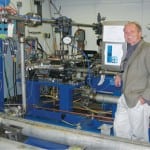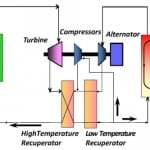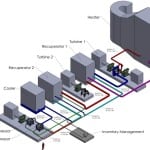Researchers at Sandia National Laboratories in New Mexico announced they completed a successful test of a new power-generating technology, delivering electricity to the local grid using an energy conversion system that they say could drive a major increase in efficiency for power plants across the U.S. and perhaps the world.
The researchers, in a news release from the U.S. Dept. of Energy’s (DOE’s) Office of Nuclear Energy, said they developed a simple recuperated closed-loop Brayton cycle that uses supercritical carbon dioxide (CO2) as the working fluid. The lab said the gas runs through a continuous loop of being pressurized, heated, and expanded through a turbine to generate electricity. After the fluid exits the turbine, it is cooled in a recuperator before returning to a compressor to complete the cycle.
Want to learn more about supercritical CO2? Read this POWER Interview with a program director from the Gas Technology Institute. And go here to read a library of articles about supercritical CO2 published by POWER in recent years.
The group tested the system for several months. In the successful test earlier this year, they used an electric heater to push the temperature of the supercritical CO2 to 600F. They then used advanced power electronics, which were adapted from an elevator controls company, to send power into the nearby Sandia-Kirtland Air Force Base electrical grid.
The researchers said that during the test, the grid received continuous power for 50 minutes, with as much as 10 kW of electricity produced at the peak. The lab said that amount is about one-third of the electricity used by an average U.S. home each day.
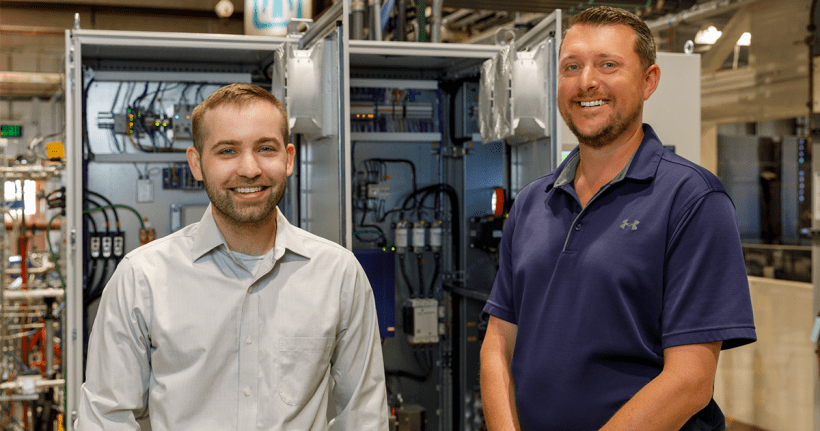
The recent test marked the first time the military base’s grid operators agreed to take power from the system. Previously, any power produced during testing was “dumped” into load banks to avoid possible grid disruptions.
“We’ve been striving to get here for a number of years, and to be able to demonstrate that we can connect our system through a commercial device to the grid is the first bridge to more efficient electricity generation,” said Rodney Keith, manager for the advanced concepts group working on the Brayton cycle technology at the Albuquerque-based lab.
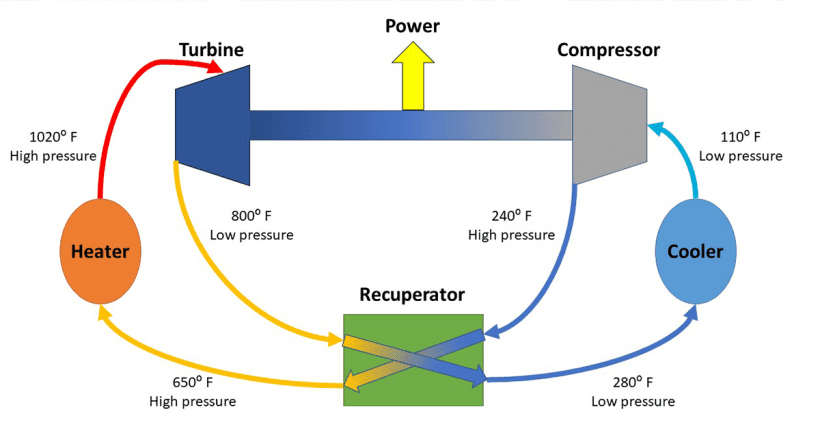
Many of today’s operating power plants, including thermal generators such as coal-fired, nuclear, and natural gas-fired units, use a steam-based Rankine cycle to convert the heat they produce into electricity. The researchers noted those systems may lose as much as two-thirds of the energy that could potentially be produced when converting steam into water to repeat the cycle.
Researchers Logan Rapp and Darryn Fleming on Sept. 12 told POWER that the Sandia project “is different from what is going on at the STEP pilot plant at SWRI mainly due to the power level. The STEP pilot plant is a 10-MWe commercial scale facility, so the generator/power electronics are more traditional technology adapted from the steam Rankine industry. We are working on significantly smaller-scale machines, with <1MWe.”
The researchers said, “We also employ turbomachinery that combines a turbine, alternator/motor, and compressor all on a single shaft. At this power level and turbomachinery configuration, we use a permanent magnet rotor which can operate in either motoring or generating mode; that is, during startup we can supply power to the spin the rotor in motoring mode, and once the cycle is operating at temperature we can extract power in generating mode.”
Rapp and Fleming said, “This requires power electronics to control the direction of power flow and to ensure the power generated is of sufficient quality to pass onto a commercial AC power grid.” The researchers said the project at Sandia is “the first successful test of new power electronics which demonstrated the ability to both consume power from the grid in motoring mode and reject power back to the grid during generating mode.”
The Sandia researchers said supercritical Brayton cycle systems could possibly improve that efficiency up to 50%, largely due to the hotter temperatures that the material can reach—as much as 1,290F. They said that could result in dramatic efficiency improvements at thermal generating facilities, and also could upgrade the performance of concentrated solar power, or CSP, systems.
According to the researchers, supercritical CO2 “is a non-toxic, stable material that is under so much pressure it acts like both a liquid and a gas. This carbon dioxide, which stays within the system and is not released as a greenhouse gas, can get much hotter than steam—1,290 degrees Fahrenheit or 700 Celsius. Partially because of this heat, the Brayton cycle has the potential to be much more efficient at turning heat from power plants—nuclear, natural gas or even concentrated solar—into energy than the traditional steam-based Rankine cycle. Because so much energy is lost turning steam back into water in the Rankine cycle, at most a third of the power in the steam can be converted into electricity. In comparison, the Brayton cycle has a theoretical conversion efficiency upwards of 50%.”
The lab on Sept. 1 said it already is working on scaling up the supercritical Brayton cycle technology. Researchers said future tests “will demonstrate a recompression closed Brayton cycle and then progress to a 1 MW-scale generator that will not need electrical power from the grid to heat the supercritical carbon dioxide.”
The Sandia project is supported by the DOE’s Supercritical Transformational Electric Power (STEP) program, which is co-sponsored by the offices of Nuclear Energy, Fossil Energy and Carbon Management, and Energy Efficiency and Renewable Energy. The DOE said the STEP program “works with industry to develop and mature technology to help commercialize supercritical carbon dioxide power cycle systems.”
—Darrell Proctor is a senior associate editor for POWER (@POWERmagazine).








